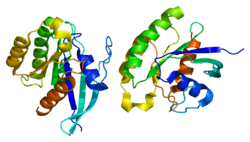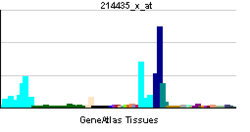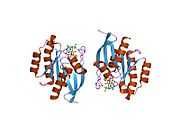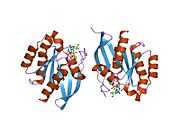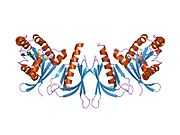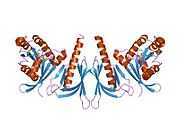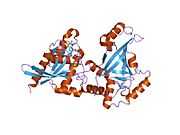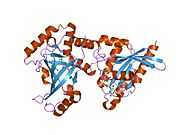RALA
Ras-related protein Ral-A is a protein that in humans is encoded by the RALA gene.[1][2]
Function
The product of this gene belongs to the small GTPase superfamily, Ras family of proteins. GTP-binding proteins mediate the transmembrane signaling initiated by the occupancy of certain cell surface receptors. This gene encodes a low molecular mass ras-like GTP-binding protein that shares about 50% similarity with other ras proteins.[2]
The direct effects of RalA are uncertain, but it has been shown to play a significant role in filopodia formation[3] and activity-dependent growth of postsynaptic membranes[4] through its interactions with several downstream mediators including the exocyst complex.
Interactions
RALA has been shown to interact with:
References
- ↑ Rousseau-Merck MF, Bernheim A, Chardin P, Miglierina R, Tavitian A, Berger R (Aug 1988). "The ras-related ral gene maps to chromosome 7p15-22". Hum Genet 79 (2): 132–6. doi:10.1007/BF00280551. PMID 3292391.
- ↑ 2.0 2.1 "Entrez Gene: RALA v-ral simian leukemia viral oncogene homolog A (ras related)".
- ↑ Sugihara K, Asano S, Tanaka K, Iwamatsu A, Okawa K, Ohta Y (January 2002). "The exocyst complex binds the small GTPase RalA to mediate filopodia formation". Nat. Cell Biol. 4 (1): 73–8. doi:10.1038/ncb720. PMID 11744922.
- ↑ Teodoro RO, Pekkurnaz G, Nasser A, Higashi-Kovtun ME, Balakireva M, McLachlan IG, Camonis J, Schwarz TL (July 2013). "Ral mediates activity-dependent growth of postsynaptic membranes via recruitment of the exocyst". EMBO J. 32 (14): 2039–55. doi:10.1038/emboj.2013.147. PMID 23812009.
- ↑ Ohta Y, Suzuki N, Nakamura S, Hartwig JH, Stossel TP (1999). "The small GTPase RalA targets filamin to induce filopodia". Proc. Natl. Acad. Sci. U.S.A. 96 (5): 2122–8. doi:10.1073/pnas.96.5.2122. PMC 26747. PMID 10051605.
- ↑ Luo JQ, Liu X, Hammond SM, Colley WC, Feig LA, Frohman MA, Morris AJ, Foster DA (1997). "RalA interacts directly with the Arf-responsive, PIP2-dependent phospholipase D1". Biochem. Biophys. Res. Commun. 235 (3): 854–9. doi:10.1006/bbrc.1997.6793. PMID 9207251.
- ↑ Kim JH, Lee SD, Han JM, Lee TG, Kim Y, Park JB, Lambeth JD, Suh PG, Ryu SH (1998). "Activation of phospholipase D1 by direct interaction with ADP-ribosylation factor 1 and RalA". FEBS Lett. 430 (3): 231–5. doi:10.1016/S0014-5793(98)00661-9. PMID 9688545.
- ↑ Moskalenko S, Tong C, Rosse C, Mirey G, Formstecher E, Daviet L, Camonis J, White MA (2003). "Ral GTPases regulate exocyst assembly through dual subunit interactions". J. Biol. Chem. 278 (51): 51743–8. doi:10.1074/jbc.M308702200. PMID 14525976.
- ↑ Jullien-Flores V, Dorseuil O, Romero F, Letourneur F, Saragosti S, Berger R, Tavitian A, Gacon G, Camonis JH (1995). "Bridging Ral GTPase to Rho pathways. RLIP76, a Ral effector with CDC42/Rac GTPase-activating protein activity". J. Biol. Chem. 270 (38): 22473–7. doi:10.1074/jbc.270.38.22473. PMID 7673236.
- ↑ Cantor SB, Urano T, Feig LA (1995). "Identification and characterization of Ral-binding protein 1, a potential downstream target of Ral GTPases". Mol. Cell. Biol. 15 (8): 4578–84. PMC 230698. PMID 7623849.
- ↑ Ikeda M, Ishida O, Hinoi T, Kishida S, Kikuchi A (1998). "Identification and characterization of a novel protein interacting with Ral-binding protein 1, a putative effector protein of Ral". J. Biol. Chem. 273 (2): 814–21. doi:10.1074/jbc.273.2.814. PMID 9422736.
Further reading
- Kinsella BT, Erdman RA, Maltese WA (1991). "Carboxyl-terminal isoprenylation of ras-related GTP-binding proteins encoded by rac1, rac2, and ralA". J. Biol. Chem. 266 (15): 9786–94. PMID 1903399.
- Polakis PG, Weber RF, Nevins B et al. (1989). "Identification of the ral and rac1 gene products, low molecular mass GTP-binding proteins from human platelets". J. Biol. Chem. 264 (28): 16383–9. PMID 2550440.
- Chardin P, Tavitian A (1989). "Coding sequences of human ralA and ralB cDNAs". Nucleic Acids Res. 17 (11): 4380. doi:10.1093/nar/17.11.4380. PMC 317954. PMID 2662142.
- Cantor SB, Urano T, Feig LA (1995). "Identification and characterization of Ral-binding protein 1, a potential downstream target of Ral GTPases". Mol. Cell. Biol. 15 (8): 4578–84. PMC 230698. PMID 7623849.
- Jullien-Flores V, Dorseuil O, Romero F et al. (1995). "Bridging Ral GTPase to Rho pathways. RLIP76, a Ral effector with CDC42/Rac GTPase-activating protein activity". J. Biol. Chem. 270 (38): 22473–7. doi:10.1074/jbc.270.38.22473. PMID 7673236.
- Wang KL, Khan MT, Roufogalis BD (1997). "Identification and characterization of a calmodulin-binding domain in Ral-A, a Ras-related GTP-binding protein purified from human erythrocyte membrane". J. Biol. Chem. 272 (25): 16002–9. doi:10.1074/jbc.272.25.16002. PMID 9188503.
- Luo JQ, Liu X, Hammond SM et al. (1997). "RalA interacts directly with the Arf-responsive, PIP2-dependent phospholipase D1". Biochem. Biophys. Res. Commun. 235 (3): 854–9. doi:10.1006/bbrc.1997.6793. PMID 9207251.
- Ikeda M, Ishida O, Hinoi T et al. (1998). "Identification and characterization of a novel protein interacting with Ral-binding protein 1, a putative effector protein of Ral". J. Biol. Chem. 273 (2): 814–21. doi:10.1074/jbc.273.2.814. PMID 9422736.
- Vavvas D, Li X, Avruch J, Zhang XF (1998). "Identification of Nore1 as a potential Ras effector". J. Biol. Chem. 273 (10): 5439–42. doi:10.1074/jbc.273.10.5439. PMID 9488663.
- Kim JH, Lee SD, Han JM et al. (1998). "Activation of phospholipase D1 by direct interaction with ADP-ribosylation factor 1 and RalA". FEBS Lett. 430 (3): 231–5. doi:10.1016/S0014-5793(98)00661-9. PMID 9688545.
- Ohta Y, Suzuki N, Nakamura S et al. (1999). "The small GTPase RalA targets filamin to induce filopodia". Proc. Natl. Acad. Sci. U.S.A. 96 (5): 2122–8. doi:10.1073/pnas.96.5.2122. PMC 26747. PMID 10051605.
- Wang KL, Roufogalis BD (1999). "Ca2+/calmodulin stimulates GTP binding to the ras-related protein ral-A". J. Biol. Chem. 274 (21): 14525–8. doi:10.1074/jbc.274.21.14525. PMID 10329639.
- Suzuki J, Yamazaki Y, Li G et al. (2000). "Involvement of Ras and Ral in Chemotactic Migration of Skeletal Myoblasts". Mol. Cell. Biol. 20 (13): 4658–65. doi:10.1128/MCB.20.13.4658-4665.2000. PMC 85875. PMID 10848592.
- de Bruyn KM, de Rooij J, Wolthuis RM et al. (2000). "RalGEF2, a pleckstrin homology domain containing guanine nucleotide exchange factor for Ral". J. Biol. Chem. 275 (38): 29761–6. doi:10.1074/jbc.M001160200. PMID 10889189.
- Brymora A, Valova VA, Larsen MR et al. (2001). "The brain exocyst complex interacts with RalA in a GTP-dependent manner: identification of a novel mammalian Sec3 gene and a second Sec15 gene". J. Biol. Chem. 276 (32): 29792–7. doi:10.1074/jbc.C100320200. PMID 11406615.
- Sugihara K, Asano S, Tanaka K et al. (2002). "The exocyst complex binds the small GTPase RalA to mediate filopodia formation". Nat. Cell Biol. 4 (1): 73–8. doi:10.1038/ncb720. PMID 11744922.
- Clough RR, Sidhu RS, Bhullar RP (2002). "Calmodulin binds RalA and RalB and is required for the thrombin-induced activation of Ral in human platelets". J. Biol. Chem. 277 (32): 28972–80. doi:10.1074/jbc.M201504200. PMID 12034722.
- Xu L, Frankel P, Jackson D et al. (2003). "Elevated Phospholipase D Activity in H-Ras- but Not K-Ras-Transformed Cells by the Synergistic Action of RalA and ARF6". Mol. Cell. Biol. 23 (2): 645–54. doi:10.1128/MCB.23.2.645-654.2003. PMC 151535. PMID 12509462.
| |||||||||||||||||||||||||
